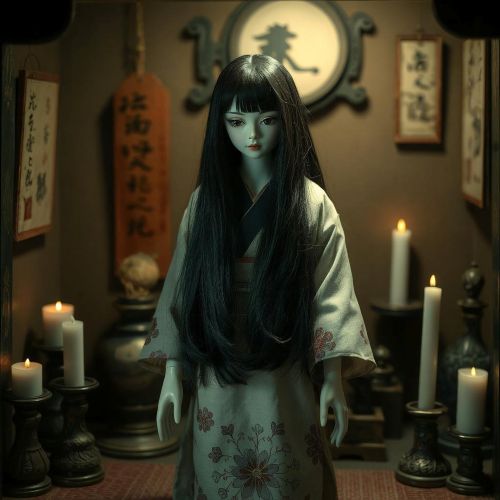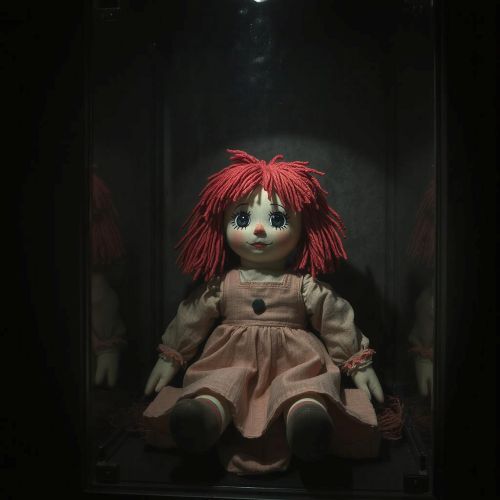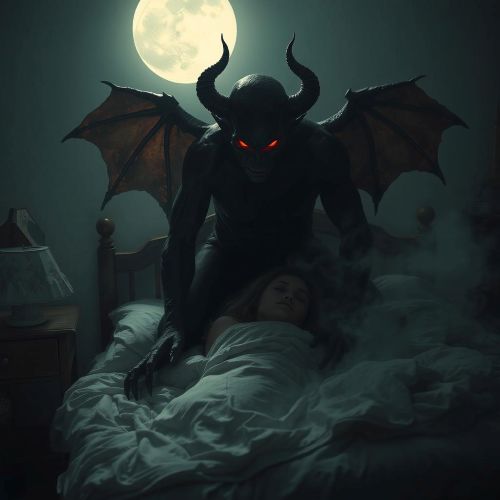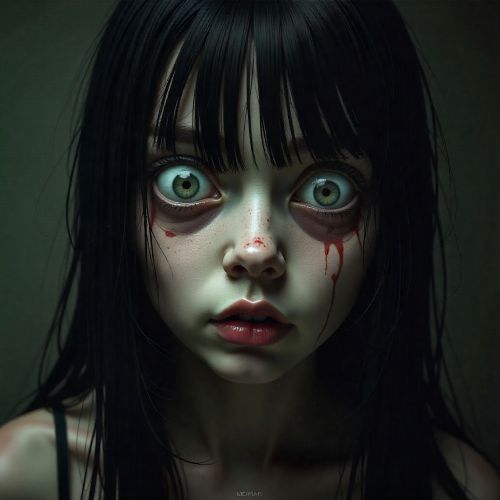Robert the Doll : The Demonic Toy
| Description | |
|---|---|
| Origin | United States of America |
| Classification | Toy |
| Demeanour | Evil |
| Habitat | Urban Areas |
| Status | Not Proved |

Introduction
Robert the Doll is one of the most notorious haunted objects in American folklore, with a chilling reputation that has spanned more than a century. Originating in Key West, Florida, Robert has become a symbol of the supernatural, inspiring countless tales of misfortune, paranormal investigation, and horror fiction. The doll once belonged to a local artist named Robert Eugene Otto, known as Gene, who received it as a gift in 1904. What started as an innocent childhood toy soon became the subject of eerie legends involving movement, whispers, and curses. Today, Robert the Doll stands as both a historical artifact and one of the most talked-about haunted dolls in the world.
Physical Attributes
Robert the Doll measures about 40 inches in height, roughly the size of a six-year-old child. He is made from fabric stuffed with wood wool, a material typical of early 20th-century dolls, and is dressed in an old-fashioned sailor suit believed to have once belonged to Gene Otto himself. His once-pale fabric has faded to a weathered brown, and his face bears an unsettling blankness — his small, beady eyes and faint grin giving him a perpetually watchful look. In his lap sits a small stuffed dog with oversized features and bulging eyes, adding to his uncanny appearance.
Experts believe Robert was manufactured by the German toy company Steiff, famous for creating the first teddy bear. Unlike typical dolls made for children, Robert’s proportions and construction suggest he was originally created as a window display model. The handcrafted nature of his design gives him a lifelike quality that only intensifies his eerie aura. His sailor outfit, paired with his expressionless face, has become an iconic image for those who visit him in the museum where he now resides.
First Sighting/Reporting
The unsettling history of Robert the Doll began in the early 1900s when Gene Otto received him as a gift. Some accounts say Gene’s grandfather purchased the doll in Germany, while other versions suggest that it was a present from a Bahamian servant who practiced voodoo or black magic and gave the doll to Gene as a curse. Gene was deeply attached to the doll, treating it as though it were alive. He gave it his own name, calling it “Robert,” and insisted that people refer to him by his middle name, Gene, instead.
Soon after Robert arrived, the Otto household experienced strange events. Gene’s parents would hear him speaking to the doll, followed by a second voice responding in a tone far deeper than Gene’s own. Objects would move without explanation, furniture would topple, and Gene would blame Robert for the chaos. Neighbors claimed they saw the doll moving from one window to another when no one was home. Terrified by these occurrences, the family eventually confined Robert to the attic, but even there, the sounds of giggling and footsteps were reportedly heard.
When Gene inherited the house as an adult, he brought Robert back down to his old bedroom and continued to keep him close. After Gene’s death in 1974, the new owners of the house also reported strange disturbances involving the doll. One owner, Myrtle Reuter, kept Robert for over twenty years before donating him to the East Martello Museum, where his legend only grew.
Other Names
Though he is most commonly known as Robert the Doll, the figure is sometimes referred to as Robert the Haunted Doll or Robert the Cursed Doll, reflecting his sinister reputation. Locals often speak his name with caution, believing that disrespecting or mocking Robert can bring misfortune. Despite his infamy, he has never acquired multiple aliases — his simplicity of name adds to the eerie personal connection that visitors and storytellers feel toward him.
Modus Operandi
The legend surrounding Robert the Doll focuses on his supposed supernatural powers and the misfortunes he brings to those who treat him carelessly. Witnesses claim he can move independently, change facial expressions, and even produce giggles. Cameras often malfunction in his presence, particularly when photographs are taken without asking his permission — a rule that museum staff strongly encourage visitors to follow. Those who ignore it frequently write letters of apology to Robert after experiencing unexplained streaks of bad luck. The East Martello Museum receives hundreds of these letters each year from people hoping to reverse what they believe is a curse.
Many who encounter Robert report sudden feelings of dread or unease, as though being watched. Some museum visitors describe him shifting slightly within his display case or noticing subtle changes in his eyes and smile. Staff members also claim that Robert reacts differently to people depending on their attitude — growing more “agitated” when mocked or disrespected.
Over time, theories have emerged to explain Robert’s alleged powers. Some say the doll is possessed by a mischievous spirit or cursed by voodoo magic. Others suggest that Gene Otto’s emotional energy, deeply tied to the doll throughout his life, left a lingering psychic imprint. While skeptics attribute the legends to exaggeration and suggestion, the persistence of identical stories over decades continues to fuel Robert’s reputation as an object of the unexplained.
Pop Culture References
Robert the Doll’s terrifying legend has become a staple of popular culture. His story inspired a series of British horror films beginning with Robert (2015), followed by sequels such as The Curse of Robert the Doll and Robert Reborn. The doll has also been featured in documentaries and television specials, including the Travel Channel’s Haunted Museum and Ghost Adventures: Artifacts, both hosted by Zak Bagans. His image appears in podcasts, books, and paranormal YouTube channels, where researchers and enthusiasts discuss his mysterious history.
The lore surrounding Robert has influenced modern horror, particularly the concept of possessed dolls like Chucky and Annabelle. He is often cited as one of the real-world inspirations for these fictional creations. Beyond horror, Robert has become a recognizable icon in ghost tourism and folklore studies, symbolizing humanity’s enduring fascination with the uncanny. His legend even extends into gaming and literature, with nods to his story appearing in fantasy novels and online horror fiction.
Current Status
Today, Robert the Doll resides permanently at the Fort East Martello Museum in Key West, Florida. He sits within a temperature-controlled glass case to protect him from humidity and decay, ensuring that the doll’s fragile materials remain intact. Despite his containment, visitors claim that Robert’s energy can still be felt throughout the room. Museum staff carefully maintain his condition and record visitor interactions, including the hundreds of apology letters he receives each year from people seeking forgiveness for mocking or photographing him without permission.
Robert’s notoriety has turned him into a major tourist attraction, drawing thousands of curious visitors annually. He has become an essential stop on Key West’s ghost tours and is featured prominently in local lore and cultural events. His social media accounts, managed by museum staff, continue to share stories, photos, and “messages” from Robert, further cementing his presence in the digital age.
Over 120 years after he was created, Robert the Doll remains one of the most famous haunted objects in the world. Whether seen as a genuine supernatural entity or a psychological phenomenon, his legend endures as a chilling reminder of how stories can transform ordinary objects into vessels of enduring fear and fascination.
Source
Wikipedia contributors. (2024). Robert (doll). Wikipedia. https://en.wikipedia.org/wiki/Robert_(doll)
Serena, K. (2024, August 17). Robert The Doll: The Real Story Of Key West’s Haunted Toy. All That’s Interesting. https://allthatsinteresting.com/robert-the-doll
Atlas Obscura. (n.d.). The Story Behind the World’s Most Terrifying Haunted Doll. https://www.atlasobscura.com/articles/story-behind-robert-the-doll
Florida Keys Public Library. (n.d.). Otto Family Collection. https://www.keyslibraries.org/otto-family-collection
Travel Channel. (2015). Haunted Museum: Robert the Doll Episode. https://www.travelchannel.com/shows/haunted-museum
Bagans, Z. (2018). Ghost Adventures: Robert the Doll Special. Discovery+. https://www.discoveryplus.com/show/ghost-adventures
Steiff Company. (n.d.). History of Steiff Dolls. https://www.steiff.com/en-us/about-steiff
East Martello Museum. (n.d.). Robert the Doll Exhibit. https://www.keywestartandhistorical.org/robert-the-doll









